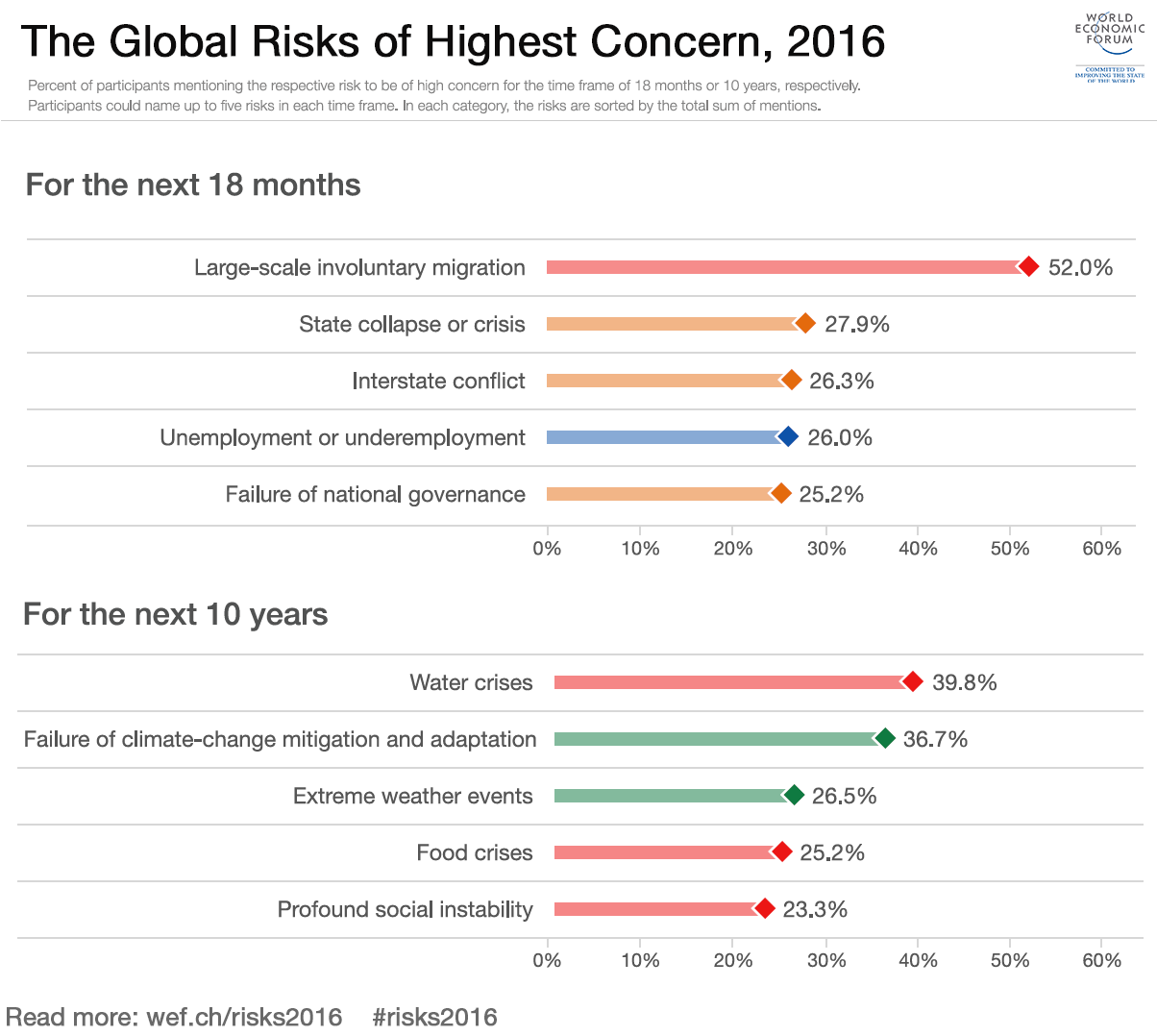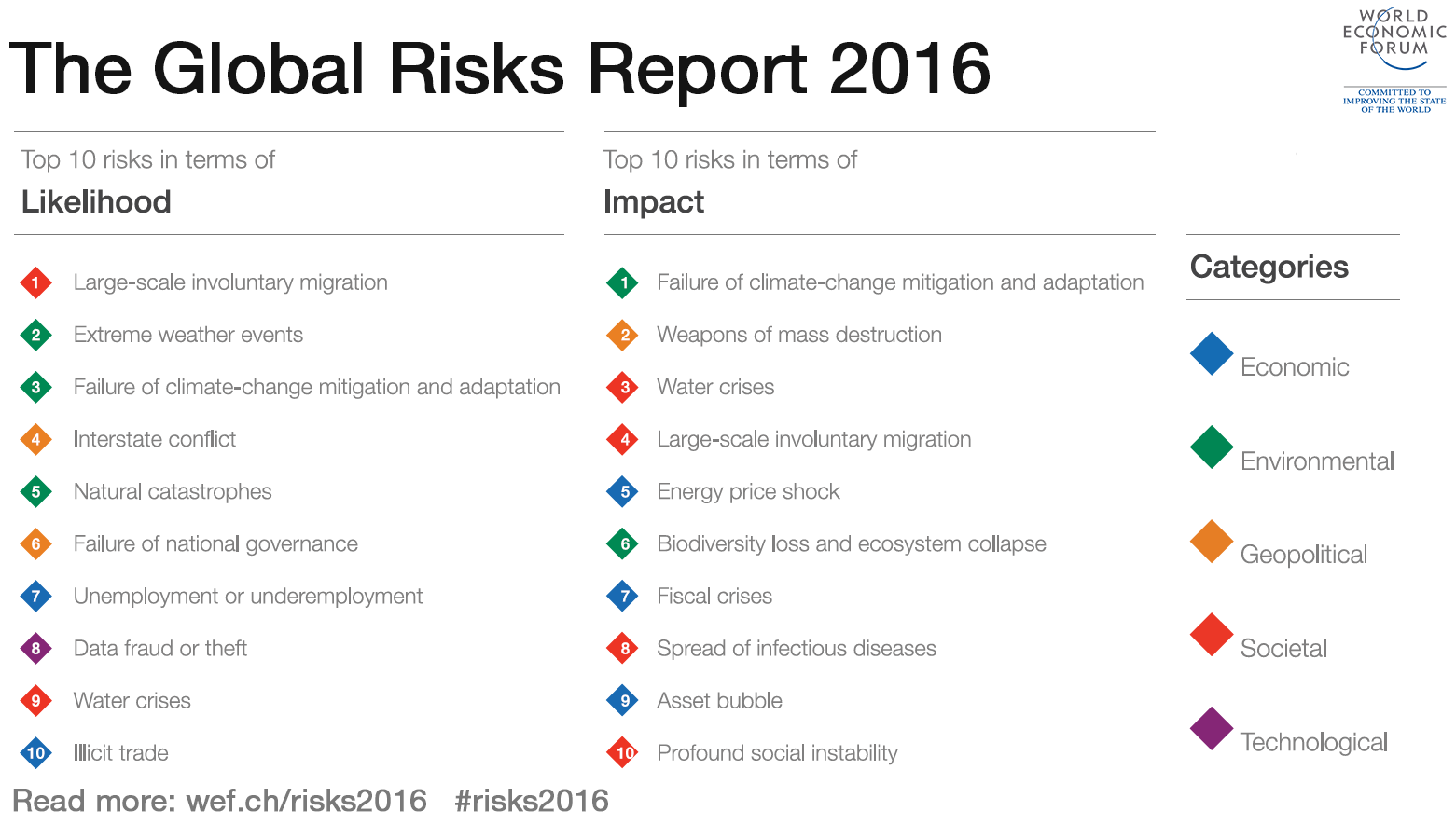What are the top global risks for 2016?

Image: Women draw drinking water on the banks of the dried-up Vakaria lake at Vakaria village, west of the western Indian city of Ahmedabad, May 14, 2011. REUTERS/Amit Dave
Stay up to date:
Global Risks
From the environment to international security and the coming Fourth Industrial Revolution, the World Economic Forum’s Global Risks Report 2016 finds risks on the rise in 2016.
In this year’s annual survey, almost 750 experts assessed 29 separate global risks for both impact and likelihood over a 10-year time horizon. The risk with the greatest potential impact in 2016 was found to be a failure of climate change mitigation and adaptation. This is the first time since the report was published in 2006 that an environmental risk has topped the ranking. This year, it was considered to have greater potential damage than weapons of mass destruction (2nd), water crises (3rd), large-scale involuntary migration (4th) and severe energy price shock (5th).

The number one risk in 2016 in terms of likelihood, meanwhile, is large-scale involuntary migration, followed by extreme weather events (2nd), failure of climate change mitigation and adaptation (3rd), interstate conflict with regional consequences (4th) and major natural catastrophes (5th).
Such a broad risk landscape is unprecedented in the 11 years the report has been measuring global risks. For the first time, four out of five categories – environmental, geopolitical, societal and economic – feature among the top five most impactful risks. The only category not to feature is technological risk, where the highest ranking risk is cyberattack, in 11th position in both likelihood and impact.

This diverse landscape comes at a time when the toll from global risks would appear to be rising. A warming climate in 2015 is likely to raise the global average surface temperature to the milestone of 1°C above the pre-industrial era for the first time. The number of people forcibly displaced in 2014 stood at 59.5 million according to UNHCR, almost 50% more than in 1940. Data from the report appears to support the increased likelihood of risks across the board, with all 24 of the risks continuously measured since 2014 having increased their likelihood scores in the past three years.
In addition to measuring their likelihood and potential impact, the Global Risks Report 2016 also examines the interconnections among the risks. Here, data suggests a convergence may be occurring, with a small number of key risks wielding great influence. All five of the most interconnected pairs of risks in 2016 accounted for more interconnections than in 2015. At the top end of the scale, 2016’s two most interconnected risks – profound social instability and structural unemployment or under-employment – account for 5% of all interconnections.
Knowledge of such interconnections is important in helping leaders prioritize areas for action, as well as to plan for contingencies. “We know climate change is exacerbating other risks such as migration and security, but these are by no means the only interconnections that are rapidly evolving to impact societies, often in unpredictable ways. Mitigation measures against such risks are important, but adaptation is vital,” said Margareta Drzeniek-Hanouz, Head of the Global Competitiveness and Risks, World Economic Forum.

Which panic button to press?
Environmental risks have come to prominence in the global risks landscape in 2016, despite the presence on the horizon of a large number of other, highly visible risks. Income disparity, which was highlighted by the report in 2014, is this year reflected in the growing interconnections involving profound social instability and both structural unemployment and underemployment and adverse consequences of technological advances.
“Events such as Europe’s refugee crisis and terrorist attacks have raised global political instability to its highest level since the Cold War. This is widening the backdrop of uncertainty against which international firms will increasingly be forced to make their strategic decisions. The need for business leaders to consider the implications of these risks on their firm’s footprint, reputation, and supply chain has never been more pressing,” said John Drzik, President, Global Risk and Specialties, Marsh.
Geopolitical risks, one of which – interstate conflict with regional consequences – was 2015’s most likely risk, are also present: while interstate conflict has dropped to fourth in terms of likelihood, weapons of mass destruction ranks as the second most impactful risk, one place higher than last year and its highest ranking ever in our report.
“Climate change is exacerbating more risks than ever before in terms of water crises, food shortages, constrained economic growth, weaker societal cohesion and increased security risks. Meanwhile, geopolitical instability is exposing businesses to cancelled projects, revoked licenses, interrupted production, damaged assets and restricted movement of funds across borders. These political conflicts are in turn making the challenge of climate change all the more insurmountable – reducing the potential for political co-operation, as well as diverting resource, innovation and time away from climate change resilience and prevention," said Cecilia Reyes, Chief Risk Officer of Zurich Insurance Group.
One potential black swan event could be in the area of technological risk. While cyberattacks rise slightly in terms of likelihood and impact in 2016, others, including failure of critical information infrastructure, appear to be declining as a risk in the eyes of experts. Technological crises have yet to impact economies or securities in a systemic way, but the risk still remains high, something that potentially may not have been fully priced in by experts. Our separate survey of business leaders assessing risks for doing business finds cyberattacks to be the top risk in no fewer than eight countries, including the USA, Japan, Germany, Switzerland and Singapore.

International security in the spotlight
In addition to assessing the likelihood and potential impact of 29 global risks, the Global Risks Report 2016 takes an in-depth look at how the global security landscape could evolve in the future. The report features the outcomes of a year-long study to examine current trends and possible driving forces for the future of international security.
Through its analysis of the interconnections between risks, the 2016 report also explores three areas where global risks have the potential to impact society. These are the concept of the “(dis)empowered citizen”, the impact of climate change on food security, and the potential of pandemics to threaten social cohesion.
Risks for doing business
For the second year, the Global Risks Report also provides country-level data on how businesses perceive global risks in their countries. This year’s analysis uncovered patterns among both advanced and emerging economies. Unemployment and under-employment appears as the risk of highest concern for doing business in more than a fourth of the 140 economies covered, and is especially featured as the top risk in two regions, sub-Saharan Africa and the Middle East and North Africa. The only region where it does not feature in the top five is North America. Energy price shock is the next most widespread risk, featuring in the top five risks for doing business in 93 economies. Cyberattacks, mentioned above, feature among the top five risks in 27 economies, indicating the extent to which businesses in many countries have been impacted already by this rising threat.
Accept our marketing cookies to access this content.
These cookies are currently disabled in your browser.
The Global Risks Report 2016 is available here.
Author: Oliver Cann, Director, Public Engagement, World Economic Forum
Don't miss any update on this topic
Create a free account and access your personalized content collection with our latest publications and analyses.
License and Republishing
World Economic Forum articles may be republished in accordance with the Creative Commons Attribution-NonCommercial-NoDerivatives 4.0 International Public License, and in accordance with our Terms of Use.
The views expressed in this article are those of the author alone and not the World Economic Forum.
Forum Stories newsletter
Bringing you weekly curated insights and analysis on the global issues that matter.
More on Global RisksSee all
Naoko Tochibayashi and Mizuho Ota
June 27, 2025
Muhammad Hassan Dajana and James Balzer
June 27, 2025
Ajit Singh and Nicole Cowell
June 24, 2025
Marco Túlio Moraes
June 18, 2025
Michele Stansfield and Eva Borge
June 2, 2025
Thomas Crampton
May 21, 2025





